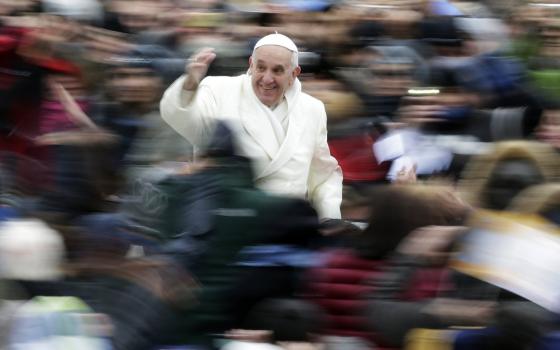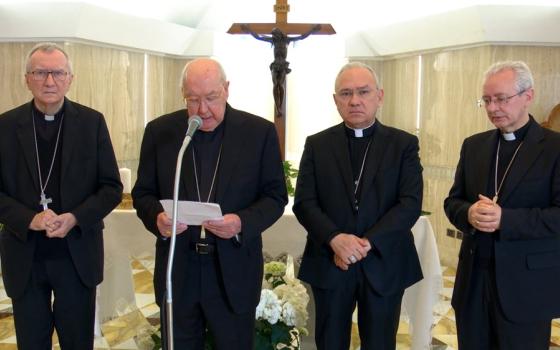
(Unsplash/Jeremy Galliani)
Earlier this autumn, Professor Richard Brown joined a panel discussion on "fake news" at the New Haven Public Library. (I reviewed Brown's book Self-Evident Truths: Contesting Equal Rights From the Revolution to the Civil War here and here.) He quoted from something James Madison wrote in 1822:
A popular Government, without popular information, or the means of acquiring it, is but a Prologue to a Farce or a Tragedy, or perhaps both. Knowledge will forever govern ignorance: And a people who mean to be their own governours, must arm themselves with the power which knowledge gives.
He went on to point out the fact that our civic life has never known an objective and unbiased media, but that nonetheless the dynamic feels different now. Brown said:
Back in the 1830s, when the "Penny Press" emerged in a few major cities, sensational, sometimes fabricated "news" stories captured audiences and earned profits. In the 1890s "Yellow" journalism created false accounts — most notably the sinking of the U.S. battleship "Maine" in Havana harbor — which gave the McKinley administration justification for declaring war on Spain. And in the 1930s, after President Franklin Roosevelt successfully employed the new medium of radio for "Fireside Chats," one of his adversaries, Father Charles Coughlin, Detroit's "radio priest," became a demagogic voice reaching up to 30 million listeners weekly in a population of 127 million. So even talk radio demagogues like Rush Limbaugh are not new. …
"Fake" is not merely false or erroneous — it is deliberately so. Deception is its purpose, its intention. Though "fake news" is, as I've said, certainly not new, I believe that the various forms and mechanisms of digital media, combined with its influence on audience expectations, has magnified, is magnifying, the influence of fake news — effectively breaking down the distinction between actual, verifiable information and false, deliberately deceptive information.
These quotes pertain to our civic life. We have a president who lies as easily as he breathes, perhaps more easily. But they also point to a reality in the life of the church today.
Last week, the so-called Catholic News Agency published a story by Ed Condon that claimed Cardinals Donald Wuerl and Blase Cupich had "collaborated extensively" on a proposal for how the U.S. bishops could handle the on-going clergy sex abuse crisis. They cited unnamed sources, one apparently "an official at the Congregation for Bishops" at the Vatican. In a report published at Crux on Monday, Cupich denied there was any collaboration in advance of the U.S. Conference of Catholic Bishops' meeting. At the meeting, he said he showed his proposal to several bishops, including Archbishop Salvatore Cordileone of San Francisco and Archbishop Charles Chaput of Philadelphia. The latter had also suggested using the review board of metropolitans to investigate charges against a bishop at the bishops' meeting. When the irony that Chaput and Cupich were backing the same proposal was pointed out, one wag commented, "And from that moment, Pilate and Herod became friends."
Now there is nothing sinister about two cardinals, both of whom are members of the Congregation for Bishops, swapping ideas. The implication seems to be that Cupich and Wuerl were working at cross purposes with the elected leaders of the conference. Someone needs to explain to Mr. Condon that sometimes Vatican staffers, especially those who might have clashed with Wuerl or Cupich, are known to lie to reporters and others, sometimes even to themselves.
Advertisement
Lord knows, the leaders of the U.S. bishops' conference could use the help because it quickly became apparent when the body of bishops discussed the proposals that they were found seriously wanting. And, rather than look for sinister explanations, perhaps the writers and editors at CNA could seek an explanation in the most obvious place: The text itself. Is it any wonder Pope Francis rejected proposals that had precisely no pastoral framework? Because the bishops have not been able to find the theological language that explains their own malfeasance? Because they still, unsurprisingly but willfully, claim the crisis is about sex and not about their own cover-up?
Condon's piece was not as bad as Philip Lawler's at First Things. His opening sentence — "By quashing the American Catholic bishops' bid for an independent investigation into the burgeoning sex-abuse scandal, the Vatican has left the US hierarchy in an impossible position." — misstates what the bishops were proposing and what the Vatican squashed. In the first place, it is not clear the crisis is burgeoning, and if it is, it is not because of any investigation being voted on by the bishops: It was the investigation by the Pennsylvania Attorney General, which pointed almost exclusively to the mishandling of sex abuse during the reign of Pope John Paul II, that caused the crisis to burgeon. Secondly, at issue was a code of conduct and a mechanism for reporting violations of that code by bishops in the future. It isn't clear what Lawler is talking about.
The only discussion of an investigation was into the former-Cardinal Theodore McCarrick affair, and the Vatican is already conducting one. Lawler is correct that the head of the National Review Board for the Protection of Children and Young People, Francesco Cesareo, called for an investigation into the charges made by ex-nuncio Archbishop Carlo Maria Viganò, specifically, in Lawler's words, the charge that "Vatican officials (including Pope Francis) had advanced McCarrick's career despite clear evidence of his misconduct." Except McCarrick had been retired for seven years by the time Francis became pope, so it is unclear how Papa Bergoglio "advanced McCarrick's career." The only bishop who mentioned Viganò was Bishop Michael Olson of Fort Worth, Texas, who called on the bishops to repudiate his call for the pope to resign.
Now, let me say that I wish the Vatican had stated its reasons more clearly and publicly as to why they squashed the enactment of these proposals. Then this guesswork for ideological purposes would have been less likely. Or would it? The Lawler piece seems to indicate that nothing will keep the enemies of Francis from fabricating significant details to paint an ugly picture of the pope's handling of clergy sex abuse, even though they never seem to raise concerns about his predecessors. Hmmmm. Nevertheless, next week, I shall consider Rome's culpability in the widespread perception that the hierarchy can't get its act together.
Catholic fake news does not exist only on the right. What to make of this article at Vanity Fair by John Cornwell? He posits that Francis and Pope Emeritus Benedict XVI are leading rival factions within the walls of the Vatican. He bases this fable on the testimony of one "middle-echelon member of the Vatican bureaucracy" with whom Cornwell splits a couple bottles of Chianti. I suppose you could say that Daniel Ellsberg was a middle-echelon bureaucrat, except he produced the documents. Cornwell? Not so much. And should someone tell him that it is not uncommon — in government, at the Vatican, even in the media — for disgruntlement to accompany a change of leadership, and that outrageous and uncorroborated allegations must be taken with a grain of salt as well as Chianti. How outrageous? Cornwell seems to be the only person not to know that Viganò taxed the patience of Benedict seven years before he launched his attack on Francis. Instead, he paints Viganò as wreaking a Benedict-inspired vengeance on the new pope. Yet this report gets distributed, and millions of people assume someone at Vanity Fair fact-checked it. Pathetic.
Of course, if you are looking in the pages of Vanity Fair for good reporting on the Catholic Church, perhaps you should not expect much. Nor is there any moral equivalence, nor equivalence of danger, between an occasional tendentious article from the Catholic left with the systematic efforts by the Catholic right to control the church's media. Robert Mickens, writing at La Croix International, details the efforts by the Catholic right to dominate the Catholic media landscape in the United States dating back decades. His article is a must-read.
We all make mistakes. But is that what is going on at CNA or First Things? I fear, instead, that a significant part of the Catholic media is engaged in a willful effort to spread falsehoods in the interest of partisan ecclesial objectives, and that they are now fulfilling what was described in 1710 by Jonathan Swift:
Few Lyes carry the Inventor's Mark, and the most prostitute Enemy to Truth may spread a thousand without being known for the Author. Besides, as the vilest Writer has his Readers, so the greatest Lyar hath his Believers; and it often happens, that if a Lye be believed for only an Hour, it hath done its Work, and there is no further Occasion for it. Falsehood flies, and Truth comes limping after it; so that when Men come to be undeceived, it is too late, the Jest is over, and the Tale has had its Effect: Like a Man who has thought of a good Repartee, when the Discourse is changed, or the Company parted: Or like a Physician, who hath found out an infallible Medicine, after the Patient is dead.
[Michael Sean Winters covers the nexus of religion and politics for NCR.]
Editor's note: Don't miss out on Michael Sean Winters' latest: Sign up to receive free newsletters and we'll notify you when he publishes new Distinctly Catholic columns.







